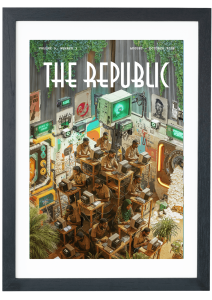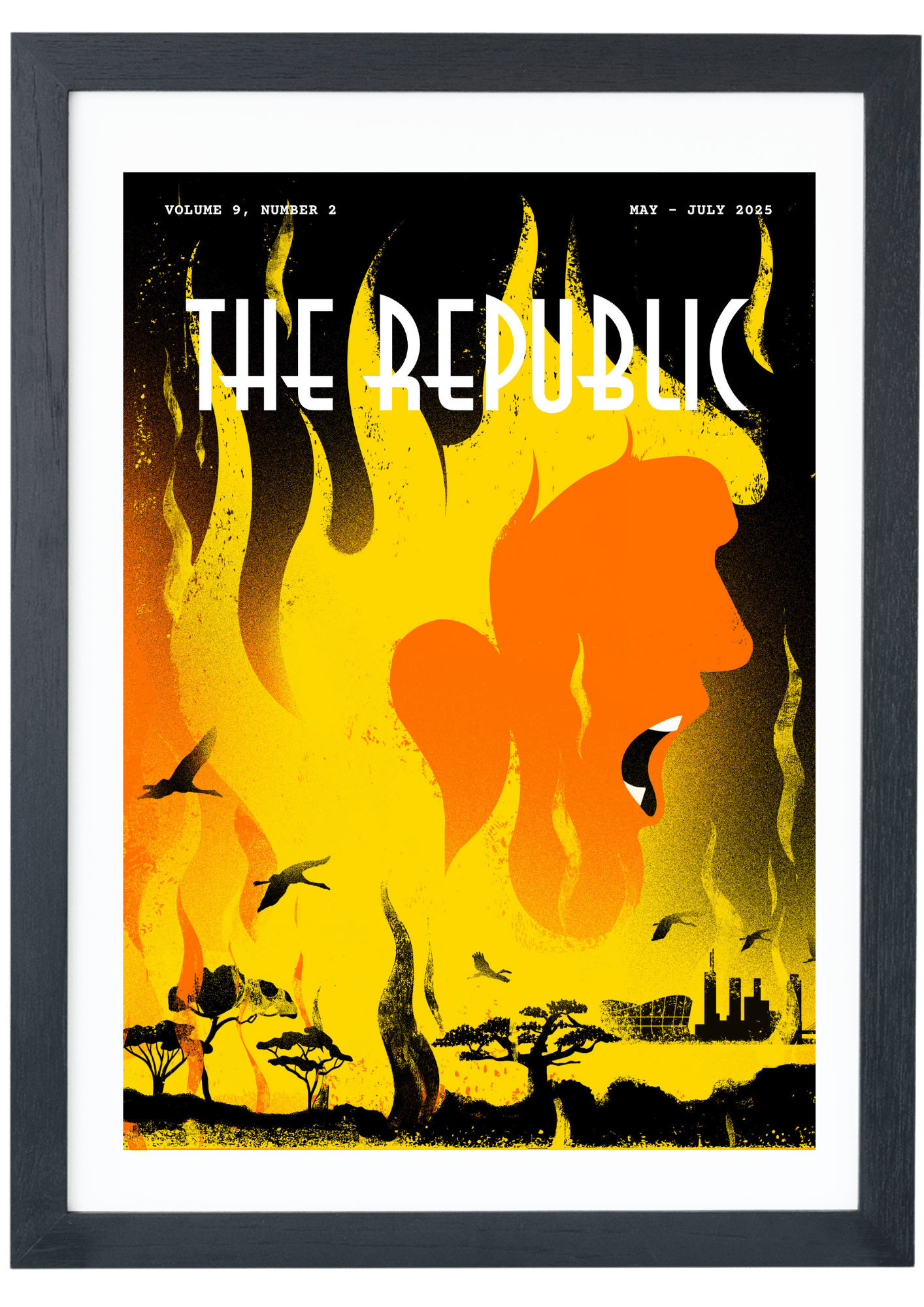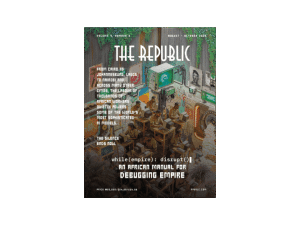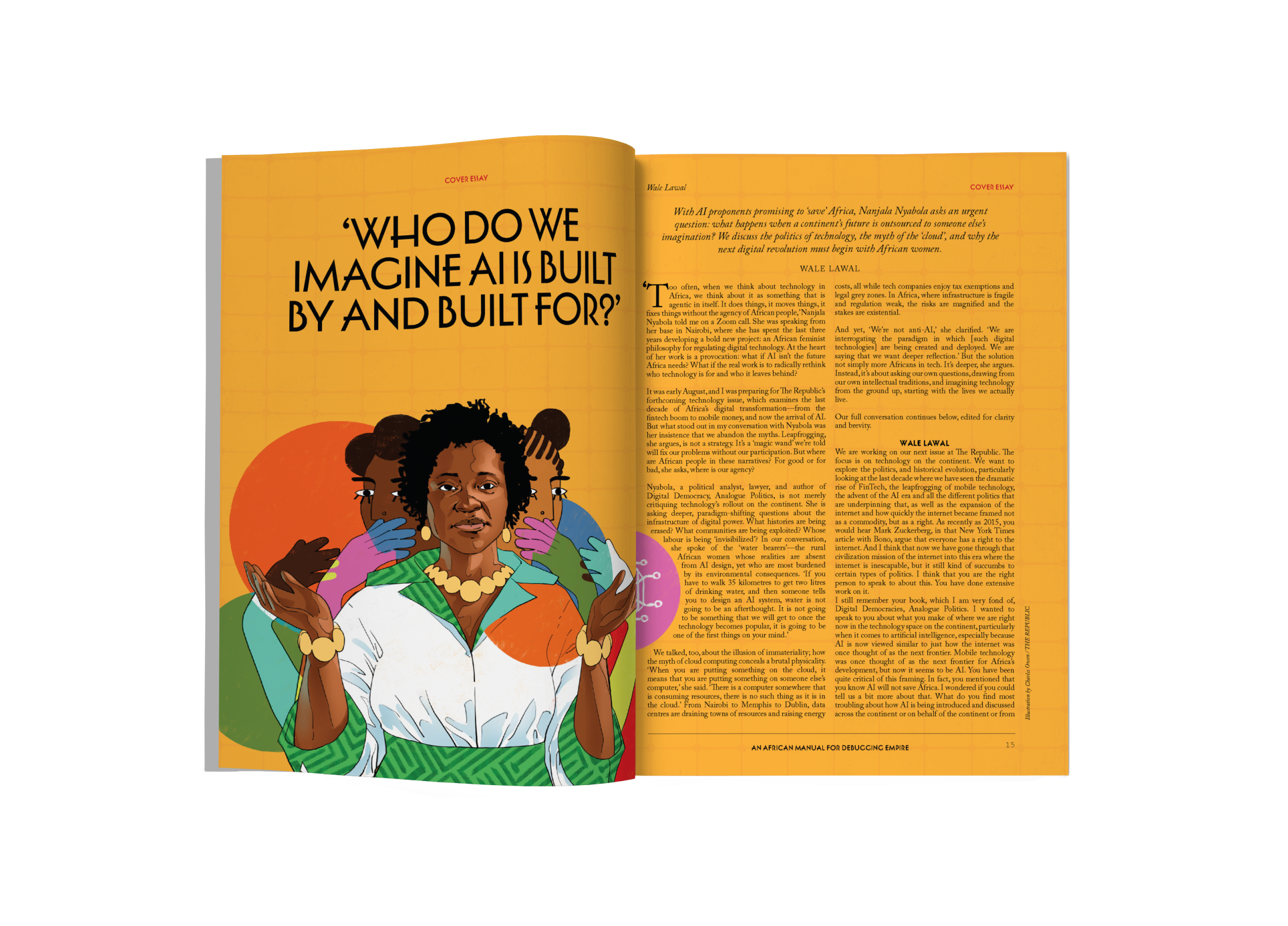
Photo illustration by Dami Mojid / THE REPUBLIC.
THE MINISTRY OF ARTS / VISUAL ART DEPT.
Is Rejecting AI Art Becoming a Conservative Position?

Photo illustration by Dami Mojid / THE REPUBLIC.
THE MINISTRY OF ARTS / VISUAL ART DEPT.
Is Rejecting AI Art Becoming a Conservative Position?
Century after century, new artistic media emerge that are initially rejected, denounced or met with resistance. In 1839, after Louis Daguerre invented the daguerreotype, the first photographic process that allowed people to capture highly detailed, permanent pictures, French painter Paul Delaroche declared: ‘From today, painting is dead!’ Likewise, Charles Baudelaire, a notable art critic of the time, called photography a ‘refuge of failed painters’ and a ‘mortal enemy’ of art. Silent films from the 19th century were seen as crude or gimmicky, the elite dismissed them as lowbrow, and theatre critics argued that they lacked the depth of stage drama. History is filled with conservatism against new media. It is therefore no surprise that, since 2015, when early experiments with Google’s DeepDream emerged, Generative AI art has faced severe criticism in the same way, with many labelling it as kitsch, and calling it mere ‘filter effects’.
THE ARGUMENT AGAINST AI ART
The initial argument against the use of AI in artmaking stems from distrust in its ability to produce anything of artistic merit. It is fundamentally not considered a medium that is ‘enough’ in itself. This is because it depends on algorithms trained on existing human-made art, pulling from different sources to make its own. It is derivative, remixing patterns rather than expressing its own original intent. It is often criticized for enabling forgeries, deepfakes, and culturally insensitive content. It lacks emotional depth, artistic authenticity, and the personal, lived experiences that make art evocative and verisimilitudinous. In a 2025 article for Vulture, Pulitzer Prize-winning critic and AI-sceptic, Jerry Saltz, remarks distastefully: ‘I can say that 90 per cent of AI art is going to be shite, and I know that is going to be true before it even happens.’
The negative effects of AI in the arts have overshadowed its positive impacts. The anti-AI camp often overlooks the fact that creating art with artificial intelligence is fast, efficient, inexpensive, and readily accessible. It is useful for creating quick mock-ups, mood boards, testing concepts, generating random reference images, and stimulating creativity. It may offer exciting (albeit controversial) trends too, such as we witnessed earlier this year when Hayao Miyazaki’s Studio Ghibli style went viral on social media following a major upgrade to ChatGPT’s image-generation tool. AI has democratized the practice of artmaking in unprecedented ways, allowing anyone with a smartphone and an idea to create complex art instantly. While much of AI art may be considered low-quality, it enables individuals with artistic sensibilities but limited traditional skills to turn their ideas into art. What we can learn from Generative AI art as it stands now is that the final work might not fulfil our artistic expectations and subjectivities like the idea(s) or concept(s) that prompted it.
The numerous forms of scepticism against AI art may be classified into the artistic, the cultural, the economic and the political, depending on specific underlying motives. The scepticism that attempts to defend traditional notions of artistry against a technology that challenges the values of human intent, manual labour, and singular authorship is artistic. The scepticism arising from cultural and economic anxieties is fuelled by a fear that AI will flood the market with mediocre content and that this would devalue the work or automate the jobs of real artists. Rejecting AI can stem from progressive concerns too, like protecting artists’ rights against exploitative data practices or critiquing AI’s environmental impact. For instance, using models like Midjourney consumes significant energy: making a single image with Generative AI uses as much energy as charging your phone. By 2027, AI is expected to consume 100 trillion-watt hours of electricity annually. These concerns can cut across political lines, but they often find louder expression in conservative circles that are wary of technological overreach.
shop the republic
-
‘The Empire Hacks Back’ by Olalekan Jeyifous by Olalekan Jeyifous
₦70,000.00 – ₦75,000.00Price range: ₦70,000.00 through ₦75,000.00 -
‘Make the World Burn Again’ by Edel Rodriguez by Edel Rodriguez
₦70,000.00 – ₦75,000.00Price range: ₦70,000.00 through ₦75,000.00 -
‘Nigerian Theatre’ Print by Shalom Ojo
₦150,000.00 -
‘Natural Synthesis’ Print by Diana Ejaita
₦70,000.00 – ₦75,000.00Price range: ₦70,000.00 through ₦75,000.00
AI’S GROWING VISIBILITY
All the foregoing arguments against AI art have, however, not stopped its growing acceptance among some creatives and visual artists. Some contemporary artists today are not only experimenting with but also centring AI in their practice, expanding the definition of authorship rather than threatening it. This is crucial for non-white artists because AI democratizes access to creative tools and platforms, which have often been gatekept by institutions that marginalize non-white and non-hetero voices. By using AI, marginalized voices can amplify their stories, aesthetics and perspectives. This can foster for them greater visibility and agency in an art world that has historically excluded them.
One of the artists engaging AI in this regard is Nigerian visual artist Àsìkò, who ‘masterfully integrates AI into his photography to explore and redefine the beauty standards of Black identity … blend[ing] photography, collage, AI, and film to present his African heritage with a modern twist that challenges conventions and captivates audiences.’ In an email chat with me, expressing his intent for embracing AI in his work, Àsìkò clarifies:
I chose to incorporate AI into my practice not because I was chasing novelty, but because it gave me another way to express complex ideas around culture, identity, and the future. For me, AI is not a replacement for artistic thought—it’s a tool I shape with intention, just like I would a camera, a pen, or fabric. It lets me enter speculative spaces to imagine futures that hold ancestral memory and technological possibility in the same breath. It allows me to blend Yoruba cosmology with machine learning, not to erase history, but to reawaken it in new forms.
Similarly, in an Instagram chat with Prince Jacon Osinachi Igwe (commonly known as Osinachi), Africa’s foremost crypto artist and the first African artist to sell an NFT at Christie’s, he remarks:
I think AI is just another tool that an artist can embrace to make their practice easier. There really is no rejecting it. It’s everywhere. I use it to generate reference images for my work. I think every artist should embrace AI. How? I think it’s unique to each person as to how they want to. AI … is a tool, and it can, in many ways, make the work of the artist easier.
A few other artists using AI in similar manner include Mayara Ferrão, a Black, queer, and feminist visual artist from Bahia, who combines ‘tenderness, technology and AI, [to] push the boundaries of queer and feminist aesthetics while questioning the algorithms that shape perception and artificial image creation.’ Another is Iranian-Canadian artist Amir Baradaran, who employs AI in his projects to explore Middle Eastern and diasporic identities, critiquing Western biases in AI systems and amplifying stories of cultural displacement. Nigerian-American artist Ayodamola Okunseinde’s Afrofuturist projects use AI to explore speculative African futures, critiquing technology’s role in marginalizing Black voices while envisioning liberated futures. Refik Anadol, the Turkish-American artist (whose work has been severely criticized by Saltz), uses AI to create immersive installations that often incorporate Middle Eastern cultural data, like architectural patterns. The list of artists who have embraced AI and centred it in their work for the sake of representation, diversity, and visibility is endless. Historically, this mirrors how photography was dismissed as ‘not art’ until it was embraced by artists like Man Ray and Cindy Sherman, who redefined its potential. In essence, the potential of AI, with its good and bad sides, can be trained, redefined, and remodelled. It therefore becomes not a question of what AI can or cannot do, but of what artists can achieve within the parameters of its growing potential and limitations.
shop the republic
Nevertheless, despite the progressive intents of these artists to develop AI systems through their work, they sometimes face significant challenges. Speaking on the challenges of using AI in his work, Àsìkò said:
AI is built on datasets that often exclude or misrepresent Black bodies and non-Western narratives. I’ve had to fight that, to train it differently, or intervene through post-production. But I see that as part of the work. If we walk away, we cede the future. If we engage critically, we can shape it.
This response from Àsìkò echoes my personal experience from early 2024, when I used Midjourney for the first time to generate images of a fictitious Nigerian astronaut stranded in outer space. At the time, I was juggling ideas for my MFA in painting thesis at Rhode Island School of Design. The so-called astronaut was Air Force Major Abacha Tunde, a Nigerian prince who allegedly flew on a Soyuz T-16Z to a secret Soviet military space station in 1989, and who was left behind when the Soviet Union fell, his seat being replaced with return cargo on the flight back to Earth. I found his story in an email scam from 2004, in which his cousin, one Dr. Tunde Bakare, was soliciting $3,000,000 to bring him back from space detention.
This astronaut’s story is made-up. Yet, I was fascinated by the fancifulness of the story and wanted to create art inspired by it. So, I subscribed to Midjourney and began generating images of an astronaut stranded on a deserted planet, taking selfies with aliens, and fetching water from cosmic rivers. Some of the images were satisfactory, but most of them were visually inaccurate. The details were noticeably clumsy, and despite tweaking the images repeatedly, Midjourney struggled to represent my vision of an African astronaut wearing a spacesuit with a Nigerian flag as a badge. The AI system, I assumed, was not familiar with images of Black astronauts, let alone African astronauts, and so it struggled to generate visually accurate images. Nonetheless, I posted the few good ones on an Instagram account called @nigerianastronautprince and gained nearly one thousand followers in three weeks. A schoolmate who knew about the project liked the idea of a fictitious astronaut Instagramming pictures from an alien world, but they expressed their dissatisfaction with the images. ‘I don’t think the pictures are artistic or realistic enough,’ they said. ‘Have you considered painting instead?’ This suggestion from my colleague broadly reflects the scepticism toward AI’s potential in the arts. However, it was because of this commentary that I stopped using Midjourney, when I could have engaged it critically and redefined it for my own purposes, which was to grant visibility to my Nigerian and African identity in AI systems.
shop the republic
AI ART: PRESENT AND FUTURE
Arguably, AI is currently the artistic medium of the present and the future. Its growing acceptance and visibility paint its detractors as conservatives who may be likened to the 19th-century Luddites—a group of English textile workers who protested the introduction of new machinery during the Industrial Revolution. When asked whether rejecting AI is fast becoming a conservative position, Àsìkò explains:
I’d say yes and no. On one hand, I understand the scepticism. Many artists worry about ethics, originality, labour, and what AI means for human creativity. These are valid concerns, and any serious user of AI must wrestle with them. But on the other hand, I’ve noticed that much of the flat-out rejection of AI often comes from a desire to preserve traditional hierarchies in art—whether around skill, access, or purity of medium. In that sense, rejection becomes less about critique and more about gatekeeping. That’s where it risks becoming a conservative posture: defending old borders rather than asking new questions. AI is a game changer, and I believe could change the course of the world as we know it, including the art world.
This could be true. AI has changed the art world significantly. After ChatGPT was released in 2022, there was a boom in text-to-image AI tools, with 34 million AI-generated images created daily by 2025. This reflects widespread use by both professional and amateur artists. Additionally, the global AI market grew by 33 per cent in 2024 and is projected to keep growing by at least 37 per cent every year until 2030. This shows the increasing demand for AI technologies across various sectors. Currently, AI is winning over young collectors: 48 per cent of millennials in a 2024 United States survey considered AI-created images as art, compared to only 39 per cent of the general population, indicating generational differences that may encourage younger artists to adopt AI. 56 per cent of individuals who encountered AI art reported enjoying it, suggesting a growing cultural acceptance that may bolster artists’ willingness to experiment with AI. Also, there is a growing visibility of AI art in auctions and exhibitions, coupled with younger collectors’ interest (in 2025, 48 per cent of bidders at Christie’s were millennials and Gen Z). The AI art market has seen rapid growth: it was valued at $212 million in 2022 and is projected to reach $5.8 billion by 2032. This economic expansion suggests increasing artist and industry involvement with AI technologies. There is also a rise of AI-generated NFTs: in 2018, Portrait of Edmond de Belamy became the first NFT to be sold at Christie’s auction, going under the hammer for $432,500. This further indicates that some artists and collectors are embracing AI art in commercial contexts, particularly in digital markets. It suggests a cultural shift toward acceptance, particularly among digital-native artists.
Furthermore, a 2024 University of Vermont survey indicates that while a majority of artists see AI as a threat, a notable percentage of 44.88 per cent (of a total of 459 artists) consider AI art models a positive development in the field. Another survey published on artsmart.ai reveals that 45.7 per cent of artists find text-to-image technology very useful, while 31.5 per cent find it somewhat useful in their artistic process. This shows that over 77 per cent of artists see value in text-to-image technology, suggesting that it enhances creativity and efficiency for many practitioners. Additionally, 78 per cent of artists believe that AI will bring new aesthetic possibilities to the world of visual arts. These signify a growing acceptance of AI among artists as both a tool and a medium of expression. In fact, from visual arts to creative writing to music, artists across disciplines are embracing machine collaboration as the next phase of artistic evolution. Even critic Saltz believes that one day a ‘Francis Bacon of AI art’ will emerge, which is fair, since Bacon is white and male. But, what about a Frida Kahlo, Njideka Akunyili Crosby or Kerry James Marshall of AI art?⎈
BUY THE MAGAZINE AND/OR THE COVER
-
‘The Empire Hacks Back’ by Olalekan Jeyifous by Olalekan Jeyifous
₦70,000.00 – ₦75,000.00Price range: ₦70,000.00 through ₦75,000.00 This product has multiple variants. The options may be chosen on the product page -
The Republic V9, N3 An African Manual for Debugging Empire
₦40,000.00
US$49.99












